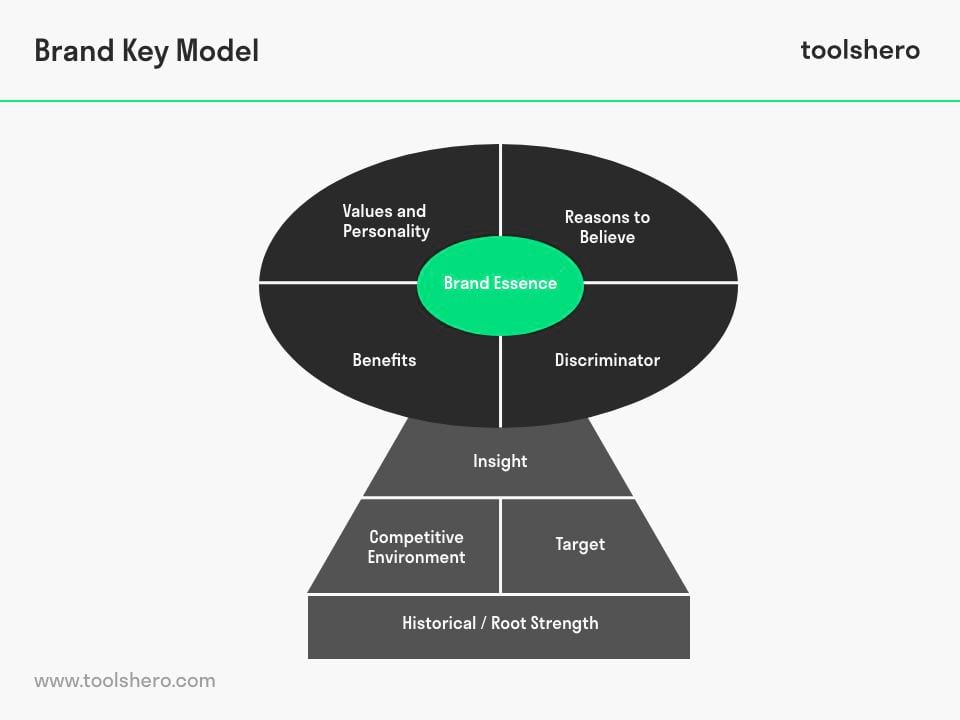Brand Key Model explained plus template

Brand key model: this article explains the Brand Key Model in a practical way. The article starts with the definition of this model, followed by an explanation of the different elements and practical tips. You will also find a downloadable Brand Key Model template to get started right away. Enjoy reading!
What is the Brand Key Model?
The Brand Key Model is a model that is used to position a brand. It is a popular tool used in many organizations, including the consumer goods giant Unilever.
The origin of the model is not entirely clear, partly because of the many variants that exist. One of the names under which the model is also known is the Brand Box.
The operation and application of the model are explained in a book by brand specialists Rik Riezebos and Jaap van der Grinten.
The model explains the nine different steps or phases involved in distinguishing a brand. Together, these parts form a visual representation of a keyhole: the brand key.
- Historical / Root Strength
- Competitive Environment
- Target
- Insight
- Benefits
- Values & Personality
- Reasons To Believe
- Discriminator
- Brand Essence
Brand Key Model: why is Building a Brand Important?
The first brands that can be shown to have been developed in a strategic way were created more than two thousand years ago. Romans provided their products with initials. These initials made it easy for customers to find the manufacturer and buy more products.
This technique is known today as branding. When starting to build a brand today, it is likely to start with describing key aspects such as brand values and brand personality. The most important competitors are also included in the initial phase. Below are the components that help build a brand according to the Brand Key Model.
Brand Key Model components

Figure 1 – The Brand Key Model (Riezebos & Van der Grinten)
1. Historical / Root Strength
The historic strength of a brand refers to the success of the brand to date. How did the brand originate? What was the original product with which the company entered the market? Which product is the brand’s flagship product? And above all: how is the brand known?
When filling in the Brand Key Model, it is important not to lose sight of how the brand has grown. Past results are no guarantee for the future, but it is possible to build on the success of the past.
A brand’s root strengths prevent consumers from quickly switching to another brand and alienating them from the company.
It is important that a brand keeps up with the times. With the passage of time, the wishes and needs of consumers also change. In general, people do not like change, so this change is preferably done in small steps.
2. Competitive Environment
The second part of the brand key is about the competitive environment of a brand. A good brand is well positioned in the market. Good positioning requires a good understanding of the competitor. This also applies to the considerations that a customer makes when making a purchase decision.
Make an inventory of which brands compete with your brand and determine how these brands position themselves in the market. What associations do consumers have with these brands? And what do they have with your brand?
3. Target
The consumer and the target audience are central to the process of brand management. In this step, the desired target audience is precisely mapped.
Describing the demographic characteristics of this group is the most important part of this. For which group of consumers is my brand the best choice?
Also describe the attitudes of the consumers in this target group, as well as their values. Consider creating multiple buyer personas as well.
These are fictitious customer profiles that may correspond to the actual customer being attracted.
Brand Management: Build Successful Long Lasting Brands
4. Insight
Insight refers to the so-called consumer insights. If a company has the ambition to become successful with a brand, it must respond to the needs of consumers in the right way. These needs are discovered by gaining insights into the customer. Another name for this is the purchase motivation, or customer motive.
Gaining insights goes beyond simply answering the question why a customer wants to buy a certain brand. It refers more to a customer’s latent needs that underlie the purchase.
Why a consumer would want to buy a product is one question, but why a customer would not want to buy the product is a second, very important question.
An example of this is Coca-Cola Light and Coca-Cola Zero. The company’s research showed that men are not likely to opt for Diet Coke because it is too feminine. The company then introduced Coca-Zero, with a tougher-looking packaging. This is what is meant by customer motives and attitudes.
5. Benefits
From here on, the brand is also studied internally. In this phase of the Brand Key Model, it is mainly about identifying the benefits of a product. These benefits can be functional, but non-functional benefits are also important, such as psychosocial benefits.
6. Values & Personality
The sixth phase of the Brand Key Model revolves around the question: which values should a brand appeal to? In other words: what does the brand stand for and what does the organization believe in when it comes to this brand? Brands based on strong values ensure a better click with the consumer. That leads to recognition, but also acknowledgment.
Two things are important when naming these values. First, the values are not explicitly communicated, but they are incorporated in the marketing message.
In addition, the marketer must realize that the values often do not emphasize the distinctive character of a brand. For marketing purposes, it is more important to emphasize how the values translate into practical implications.
Describing a brand in this way can also be done by means of personification. This means that a brand is described in terms of human personality traits or character traits. In this way, customers identify more easily with a brand.
7. Reasons to Believe
Describing the credibility of a brand is about stating arguments based on which the target group believes that the brand is the best choice. “I buy this brand because…”.
These arguments are often used in marketing messages. Concrete customer contact moments can thus be used for marketing purposes. An example of this is a testimonial.
8. Discriminator
The discriminator is about what exactly is the actual difference between this brand and other brands. It concerns the brand’s distinctive strength. “Only brand X has…”.
9. Brand Essence
This final step is a summary of phases 5 to 8. It is mainly about describing the essence of a brand in two or three words.
Advantage of the Brand Key Model
The Brand Key Model is a popular positioning model for marketers and entrepreneurs. This is especially so because all steps of positioning are clearly described.
The model guides the user through the process of branding, which is often experienced as complex. For example, an entrepreneur may know that his product or service is good, but translating this into words on paper is difficult.
Using a business name generator can be a helpful tool to generate ideas and come up with a distinctive and original brand name.
When beginning to establish a brand nowadays, it is probable to start with articulating crucial features such as brand values and brand personality.
Brand Key Model template and worksheet
To set-up your Brand Key Model, you can use this ready-to-use template / worksheet in a DOCX. format.
Download the Brand Key Model template
This template is exclusively for our paying Toolshero members. Click here to see if a membership is something for you!Now It’s Your Turn
What do you think? Do you recognize the explanation about the Brand Key Model? Have you used this model in the early stages of your business? Can you as an entrepreneur do something with this model in the current phase of your company? What other brand building models and techniques are you familiar with? Do you have any tips or comments?
Share your experience and knowledge in the comments box below.
More information
- Oxford Learning Lab (2019). Brand Management: Build Successful Long Lasting Brands. Retrieved 01/12/2024 from Udemy.
- Riezebos, R., & Grinten, J. van der (2022). Positioneren; stappenplan voor een scherpe positionering (5e druk). Boom Onderwijs, Den Haag.
- Rubinson, J., & Pfeiffer, M. (2005). Brand key performance indicators as a force for brand equity management. Journal of Advertising Research, 45(2), 187-197.
- Moroko, L., & Uncles, M. D. (2009). Employer branding and market segmentation. Journal of Brand Management, 17, 181-196.
- Zabojnik, R. (2018). Personal branding and marketing strategies. European Journal of Science and Theology, 14(6), 159-169.
How to cite this article:
Janse, B. (2023). Brand Key Model. Retrieved [insert date] from Toolshero: https://www.toolshero.com/marketing/brand-key-model/
Original publication date: 02/13/2023 | Last update: 01/12/2024
Add a link to this page on your website:
<a href=”https://www.toolshero.com/marketing/brand-key-model/”> Toolshero: Brand Key Model</a>












